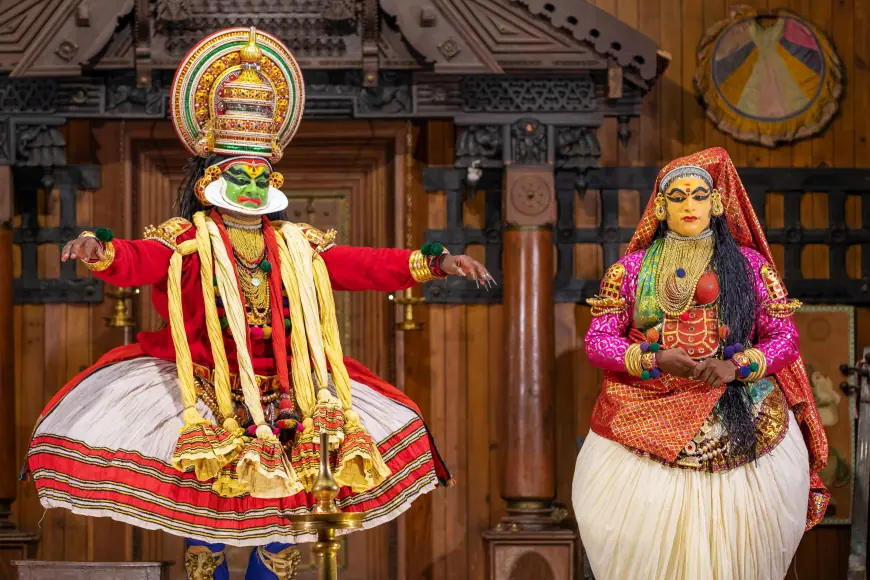Theyam & Kathakali: Experiencing Kerala’s Cultural Richness
Kerala, often called God’s Own Country, is celebrated not only for its serene backwaters, lush green hills, and golden beaches but also for its vibrant cultural traditions.

Kerala, often called God’s Own Country, is celebrated not only for its serene backwaters, lush green hills, and golden beaches but also for its vibrant cultural traditions. Among the many art forms that define Kerala’s identity, Theyyam and Kathakali stand out as two of the most enchanting performances that transport travelers into the soul of this land. These art forms are more than entertainment; they are living traditions that echo centuries of history, mythology, and devotion.
The Allure of Theyyam
Theyyam is one of Kerala’s oldest and most powerful ritualistic performances, primarily found in the northern Malabar region. The name Theyyam is derived from the word Daivam, meaning “God.” True to its meaning, the performers of Theyyam are believed to transform into divine beings during the performance.
The visual spectacle begins when the artists, clad in elaborate costumes, face paints, and towering headdresses, prepare themselves for the ritual. The colors used in the makeup are symbolic—red for strength, white for purity, and black for power. The rhythmic beats of drums, chants, and the hypnotic dance movements create an atmosphere charged with spirituality and mysticism.
For the local communities, Theyyam is not merely an art but a sacred offering. Villagers gather around the sacred groves or temple courtyards to witness the performance, seeking blessings and guidance from the deity manifested through the performer. Travelers who watch Theyyam often describe it as an otherworldly experience—something that feels like stepping back into a time when myths and reality were intertwined.
The Grandeur of Kathakali
If Theyyam represents raw, ritualistic energy, Kathakali epitomizes refined artistry and theatrical storytelling. Originating in the 17th century, Kathakali is one of the most recognized classical dance-drama traditions of India.
The highlight of Kathakali lies in its attention to detail. Every gesture, facial expression, and movement carries meaning. Known as Mudras, these hand gestures and facial expressions are a language of their own, narrating stories from the great Indian epics—the Ramayana, Mahabharata, and Puranas.
The elaborate makeup process itself is a performance. Actors spend hours applying layers of natural colors to achieve striking looks that distinguish gods, demons, and heroes. The green face represents noble characters, while red and black are reserved for villains and demonic figures.
The accompanying music, performed live with instruments like the chenda (drum) and cymbals, heightens the intensity of the performance. Unlike conventional theater, Kathakali unfolds slowly, allowing the audience to fully immerse in the story. Watching it under the oil lamps in a traditional theater or a temple courtyard can be one of the most captivating cultural experiences in Kerala.
Cultural Immersion Beyond Performances
Kerala’s cultural richness extends beyond Theyyam and Kathakali. From temple festivals with grand elephant processions to melodious Carnatic music recitals and martial art demonstrations like Kalaripayattu, the state offers a mosaic of traditions.
For travelers planning their journey, weaving cultural experiences into their Kerala tour itinerary ensures that they not only see the natural beauty of the state but also connect with its living heritage. A well-curated itinerary could include a Theyyam performance in Kannur, a Kathakali show in Kochi, a houseboat ride through Alleppey, and a visit to the tea gardens of Munnar—all blending together to offer a complete experience of Kerala.
Why Cultural Tourism Matters in Kerala
Tourism in Kerala thrives on two pillars: nature and culture. While the backwaters and beaches attract visitors from around the globe, it is the cultural experiences that create lasting impressions. Watching Theyyam and Kathakali provides travelers with more than just entertainment—it gives them an understanding of how myths, rituals, and stories shape everyday life in Kerala.
By supporting these performances, visitors also contribute to preserving art forms that are passed down generations. Many artists dedicate their lives to keeping the traditions alive, often training from childhood to master the intricate skills required.
Tips for Experiencing Theyyam and Kathakali
-
Timing is Key: Theyyam is usually performed between October and May, aligned with temple festivals in North Kerala. Kathakali performances, on the other hand, are held year-round at cultural centers in Kochi, Thekkady, and other tourist hubs.
-
Arrive Early: Both art forms are detailed and layered. Reaching early allows you to witness preparations like makeup application, which adds depth to the overall experience.
-
Dress Respectfully: Since Theyyam performances are part of religious rituals, wearing modest clothing shows respect to the tradition.
-
Learn a Little Background: Reading about the story or myth being performed helps you connect with the performance more deeply.
-
Choose Authentic Venues: While tourist versions exist, witnessing Theyyam in its traditional village setting or Kathakali in a respected cultural theater makes the experience more authentic.
Culinary and Local Experiences
After immersing in cultural shows, indulging in Kerala’s cuisine further enhances the journey. A traditional Sadya (vegetarian feast served on a banana leaf) or delicacies like appam with stew, Kerala fish curry, and Malabar biryani perfectly complement cultural exploration.
Pairing such cultural experiences with homestays or heritage resorts can create a more immersive trip. Many hosts are eager to share stories, local customs, and even arrange access to village performances or cooking sessions.
From Hyderabad to Kerala: The Cultural Journey
For travelers from other parts of India, Kerala is easily accessible by air, rail, and road. In fact, there are several Hyderabad to Kerala package options that combine flights, accommodation, guided tours, and cultural experiences. These packages often make it easier for families or groups to plan without worrying about logistics, while still offering room for personalized exploration.
Travelers opting for such packages can choose to focus on cultural immersion, nature trails, or a blend of both. Whether it’s a week-long holiday covering Kochi, Munnar, and Alleppey or a shorter getaway highlighting cultural evenings with Kathakali and temple festivals, Kerala promises an enriching experience for everyone.
Conclusion
Theyyam and Kathakali represent the two extremes of Kerala’s cultural spectrum—one raw and divine, the other refined and theatrical. Together, they paint a vivid picture of Kerala’s artistic soul. Experiencing them is like stepping into a living museum where stories, gods, and traditions come alive before your eyes.
As you craft your Kerala journey, remember that culture is as integral as landscapes. By including traditional performances in your travel plans, you take home not just photographs but memories of a heritage that continues to thrive in the hearts of the people. Kerala invites you not only to witness its beauty but to experience its soul through Theyyam, Kathakali, and countless other traditions that make it truly unforgettable.
What's Your Reaction?
 Like
0
Like
0
 Dislike
0
Dislike
0
 Love
0
Love
0
 Funny
0
Funny
0
 Angry
0
Angry
0
 Sad
0
Sad
0
 Wow
0
Wow
0


















































